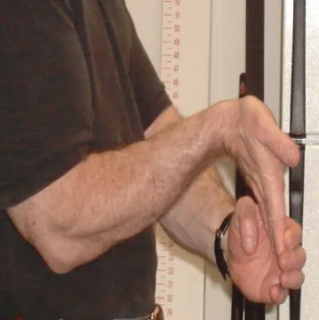By guest blogger
Scott Bradley DPT, PT, CSCS
If you have pain on the inside of your elbow with certain movements then you might have golfer’s elbow or what we call in the business, Medial Epicondylitis. Golfer’s elbow can happen to almost anyone and can cause pain and weakness with normal activities like doing a biceps curl, opening a jar, carrying objects, or putting things on a shelf. Golfer’s elbow also presents in a wide variety of sports including swimming, baseball, golf, softball, and even tennis.
Golfer’s elbow is typically located at the proximal attachment of the common flexor tendon at the inside of the elbow, which is where most of the forearm muscles that flex the wrist are located. The two muscles most commonly affected with this injury are the pronator teres and flexor carpi radialis.

Golfer’s elbow is caused by repetitive microtrauma to the common flexor tendon at the medial epicondyle of the elbow, hence why it is called medial epicondylitis in the medical community. This condition can be an acute or chronic issue. Acutely, an average person will play 9 holes or do some housework with power tools which will cause some nagging pain on the inside of the elbow. This pain usually resolves within an hour after activity. The load applied on the muscles exceeds the body's ability to handle, resulting in microtrauma to the area. This microtrauma results in acute inflammation and pain. This is the most common case and if not properly addressed it can become a chronic issue which will require more intensive therapy.
My Doctor Recommended an Injection, Is it a Good Idea?
Instant relief of pain will always sound good, but will it accelerate the healing process? The answer is probably not. The cortisone injection will assist in relieving the annoying pain but little else; it will not fix the underlying issue associated with Golfer’s elbow. Once the pain is gone many people will continue doing the activity that caused the pain. Without the proper exercises and stretches however, you will have pain again once the injection wears off. The best advice I give my patients is that if the pain is unbearable a cortisone injection may assist in relieving the initial pain but physical therapy will help fix the underlying problem. This is also supported by the research.
This research article found that those who had a corticosteroid injection had reduced pain at 6 weeks following the injection but had no difference in symptoms compared to the control group at 3 and 12 months. (1)
How Do I Fix It?
Exercise- Duh! Below are some simple beginner exercises you can do to help accelerate the healing process and reduce pain.
Wrist Flexion Isometrics
- Bend the wrist of your injured hand slightly
- Place the opposite hand on the palm of your hand
- Press into hand for 6 seconds and repeat 20 times
Forearm Pronation Isometrics
- Place arm on table with thumb up
- Place opposite hand on the top aspect of the inside of the forearm
- Then press forearm into hand for 6 seconds and repeat 20 times
Elbow Flexion Isometrics
- Place your affected elbow bent to about 90 degrees with your palm facing upward on a table. Place your opposite hand on your affected wrist.
- Press wrist into hand for 6 seconds and repeat 20 times
Wrist Flexion Stretch Arm Straight
- Hold the arm to be stretched straight out in front of you with your palm facing toward the ceiling.
- Grasp your hand with the other hand, and slowly bend the wrist downward so that the fingers point toward the floor.
- Hold this stretch for 30 seconds, repeat 3 times
Wrist Flexion Stretch Arm Bent
- Bend the affected elbow so that it is at a 90 degree angle
- Place the other hand on the affected arm’s fingers
- Gently pull back on your fingers until a stretch is felt
- Hold this stretch for 30 seconds, repeat 3 times
There is no one size fits all recovery program for Golfer’s elbow. The earlier you address the symptoms the faster your recovery and the less restriction in your daily activity. A combination of conservative treatments to start with consisting of: isometrics, eccentrics and gentle stretches are great starting points. If you are still having trouble tackling the nagging pain on the inside of your elbow seek out a qualified physical therapist to help you in your recovery process. Most Golfer’s elbows resolve within a year with no surgery. So stay consistent with your exercises and hopefully you will be back to playing 18 holes in no time.
About Scott Bradley DPT, PT, CSCS
Scott graduated from Florida Gulf Coast University with his degree in exercise science and his Strength and Conditioning Certification. He attended Wheeling Jesuit University PT program. Scott has experience working with D1 athletes, NFL pros and NFL combine training. Scott currently works in Fort Myers, Fl in an outpatient physical therapy setting specializing in golf recovery.
References
Taylor SA, Hannafin JA (2012) Evaluation and management of elbow tendinopathy. Sports Health 4: 384-393.What is Golfer's Elbow and How to Treat













